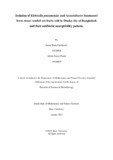| dc.contributor.advisor | Monjurul Haque, Dr. Fahim Kabir | |
| dc.contributor.author | Farid(Safa), Saima Binta | |
| dc.contributor.author | Prami, Afrida Nawer | |
| dc.date.accessioned | 2024-01-10T08:24:37Z | |
| dc.date.available | 2024-01-10T08:24:37Z | |
| dc.date.copyright | 2023 | |
| dc.date.issued | 2023-01 | |
| dc.identifier.other | ID: 18326026 | |
| dc.identifier.other | ID: 18326029 | |
| dc.identifier.uri | http://hdl.handle.net/10361/22104 | |
| dc.description | This thesis is submitted in partial fulfillment of the requirements for the degree of Bachelor of Science in Microbiology, 2023. | en_US |
| dc.description | Catalogued from PDF version of thesis. | |
| dc.description | Includes bibliographical references (page 40). | |
| dc.description.abstract | The consumption of street vended ready-to-eat cut fruits is very common in Dhaka City. Since
fresh produce is eaten raw, it can also pose a public health risk. So, this study was undertaken
for the isolation and identification of Acinetobacter baumannii and Klebsiella pneumoniae
from different street-vended fresh-cut fruits of 11 different areas of Dhaka city to investigate
the occurrence of pathogen in fruits from water or hand of the vendor. In this study, 68
Acinetobacter baumannii and Klebsiella pneumoniae were found from 50 samples. Three
categories of samples (fruits, hand swab and water) were collected from each vendor.
Polymerase chain reaction (PCR) test was done using selective primers for both of the
organisms. 61 out of 69 (88.4%) isolates of Klebsiella pneumoniae and 7 out of 12 (58.3%)
isolates of Acinetobacter baumannii were confirmed. Klebsiella pneumoniae were found from
all four type of fruits. Acinetobacter baumannii were found in all types of fruits except papaya.
Among them, highest and lowest isolates of bacteria were found from pineapple and hog plum
respectively. Klebsiella pneumoniae was found from fruit water and/or hand swab samples in
9 out of 11 vendors. Acinetobacter baumannii was found from both water and fruit samples
from only one vendor. Antibiotic susceptibility test was done by using 10 antibiotics of
different groups. All the isolates were resistant to Amoxicillin (78.5%), Tetracylin (82.3%),
Imipenem (18%), Amikacin (17.72%), Levofloxacin (12.65%), Colistin (50.63%), Nalidixic
acid (15.2%), Ceftriaxone (20.25%), Ceftazidime (29.11%) and Gentamycin (13.92%). In fact,
43% of Acinetobacter baumannii and 13.43% of Klebsiella pneumoniae were found as
multidrug resistant. | en_US |
| dc.description.statementofresponsibility | Saima Binta Farid(Safa) | |
| dc.description.statementofresponsibility | Afrida Nawer Prami | |
| dc.format.extent | 41 pages | |
| dc.language.iso | en | en_US |
| dc.publisher | Brac University | en_US |
| dc.rights | Brac University theses are protected by copyright. They may be viewed from this source for any purpose, but reproduction or distribution in any format is prohibited without written permission. | |
| dc.subject | Street vended cut fruit | en_US |
| dc.subject | Dhaka city | en_US |
| dc.subject | Acinetobacter baumannii | en_US |
| dc.subject | Klebsiella pneumoniae | en_US |
| dc.subject | Polymerase chain reaction | en_US |
| dc.subject | Antibiotic susceptibility test | en_US |
| dc.subject.lcsh | Klebsiella pneumoniae. | |
| dc.subject.lcsh | Infectious diseases. | |
| dc.title | Isolation of Klebsiella pneumoniae and Acinetobacter baumannii from street vended cut fruits sold in Dhaka city of Bangladesh and their antibiotic susceptibility pattern | en_US |
| dc.type | Thesis | en_US |
| dc.contributor.department | Department of Mathematics and Natural Sciences, Brac University | |
| dc.description.degree | B. Microbiology | |

